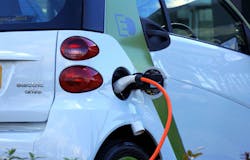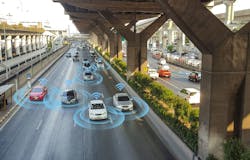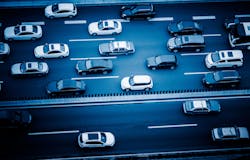New Car Tech Looks Set to Crowd the Market In The Year Ahead
The vehicle industry has been revolutionizing the ways in which we drive at an alarming pace in recent years, from self-driving and electric cars all the way through to vehicles that service themselves. Fueled by the drive to ditch fossil fuels, where does this leave manufacturers and dealerships with confused consumers looking to finance their next vehicle over the coming months?
EVs? BEVs? PHEVs and HEVs? The list goes on!
Electric vehicles swap the gas pump for a plug-in power-point.
Vehicle technology these days is nothing short of incredible, but breaking down exactly what the difference is between EVs, BEVs, PHEVs, and HEVs can prove difficult. It’s a hurdle many a marketing team will have to face in the near future as they find ways to separate themselves from the pack.
EVs & BEVs
EVs (electric vehicles) and BEVs (battery electric vehicles) are fully electric cars, which means they don’t run on petrol or diesel. That means no exhaust fumes and near-non-existent emissions, making them a popular option for those looking to buy with the environment at the top of their priority list.
One benefit of EVs and BEVs is that electric motors feature fewer moving parts than a traditional petrol or diesel vehicle. This reduces or eliminates fuel costs, oils, spark plugs, and many other typical maintenance costs that come with traditional vehicles.
Charging has always been a major sticking point, but wireless charging looks set to make that a moot point in the not-too-distant future. With this supporting technology, drivers no longer have to worry about range or finding charging stations every time the vehicle needs some juice. “You have two types of wireless charging,” says Joachim Taiber, CTO of the International Transportation Innovation Center (ITIC). “The first type is when a vehicle is stationary. This could mean parked or, for example in a city, stopped at a red light. Looking forward, a second type allows an EV to charge while moving. A car could drive over a sequence of coils in the road to charge. You could charge multiple vehicles in parallel without needing them to stop.” Instead of a carpool lane, in the future it could be possible to have a charging lane on the highway. However, a charging lane would be a large infrastructure project, which is currently not being planned any time soon.
PHEVs & HEVs
PHEVs (plug-in hybrids) and HEVs (hybrid electric cars) are a slightly different proposition. These technologies feature electric and petrol motors, allowing drivers to travel short distances electrically at a lower cost less pollution, and longer distances using fossil fuels. The drawback of plug-in hybrids are there is still a fossil fuel burning engine with many moving parts. While EVs in the U.S. will most likely charge off-peak hours in the evening, this is when many municipalities switch to coal to produce electricity. Despite this, EVs are still better for the environment in most areas of the U.S. As the grid becomes more sustainable or environmentally friendly, it is possible that full plug-in EVs will be the best environmental choice anywhere in the U.S.
Whatever the consumer chooses, electric vehicles are proving to be very popular thanks in no small part to their prices becoming far more reasonable—and viable—in recent years in an attempt to drive up adoption rates and get more environmentally friendly cars out on the roads.
Until recently the UK government offered up to £4,500 in discounts on zero-emission cars thanks to its “plug-in car grant,” which brought the purchasing price of electric cars down to a more attainable rate for UK residents. In fact, this subsidiary proved so successful, it put more than 167,000 plug-in EVs on the road.
In the U.S. “The federal Internal Revenue Service (IRS) tax credit is for $2,500 to $7,500 per new EV purchased for use in the U.S. The size of the tax credit depends on the size of the vehicle and its battery capacity,” according to energy.gov. “To find out specific tax credit amounts for individual vehicles, visit FuelEconomy.gov’s Tax Credits for Electric Vehicles and Tax Credits for Plug-in Hybrids pages. This tax credit will be available until 200,000 qualified EVs have been sold in the United States by each manufacturer, at which point the credit begins to phase out for that manufacturer. Currently, no manufacturers have been phased out yet.”
So, providing consumers can get past the initial pricing hurdles in favor of the long-term savings, the latest in electric vehicle innovations will continue to grow the EV market as prices continue to fall and the need for cleaner, greener options increase.
So, What About Autonomous Vehicles?
Autonomous vehicles are exciting, but they’re still more proof-of-concept than tangible technology.
Self-parking, automatic emergency braking, and lane keep assistance are all features designed to reduce fatalities on our roads due to human error. But are they worth the investment in this early stage of development?
The futurists of the vehicle industry are combining sensors and software to control, navigate, and drive vehicles with no driver. Tech manufacturers say driverless and autonomous cars will replace traditional vehicles so car parks will become parks again and road fatalities will plummet—at least, that’s the aim.
Technology has been speeding up in the vehicle industry, incorporating increasingly advanced artificial intelligence (AI), such as self-parking cars, in order to prepare drivers for a future where they won’t even have to touch the steering wheel.
“Uber’s self-driving prototypes use sixty-four laser beams, along with other sensors to construct their internal map. While Google’s prototypes at various stages have also used lasers, radar, high powered cameras, and sonar,” says UCSUSA.
The benefits and costs of purchasing a driverless vehicle are still largely up in the air. It’s anyone’s guess at this stage. There are still too many pieces of this technology puzzle that need to be trialed and tested in full to assess how they will impact drivers, safety, equity, the environment, and public health.
Car Tech is Speeding Down the Fast Lane
How will our highways change in the coming years as we embrace new vehicle technology?
Sooner rather than later, cars will be able to diagnose their own mechanical problems, book themselves in for appointments, renew their insurance, be controlled via voice, powered by intelligent dashboards, and be able to drive themselves.
While exciting, these technologies will continue to fill a market already bursting at the seams with petrol, diesel, electric, hybrid, semi-autonomous, and the quickly developing self-driving vehicles. The task for the industry, then, isn’t just found in the development of these new features ,but also in packaging them in a way that’s understandable by—and saleable to—a market overwhelmed by choice.
Whether they’re up for the challenge remains to be seen.




